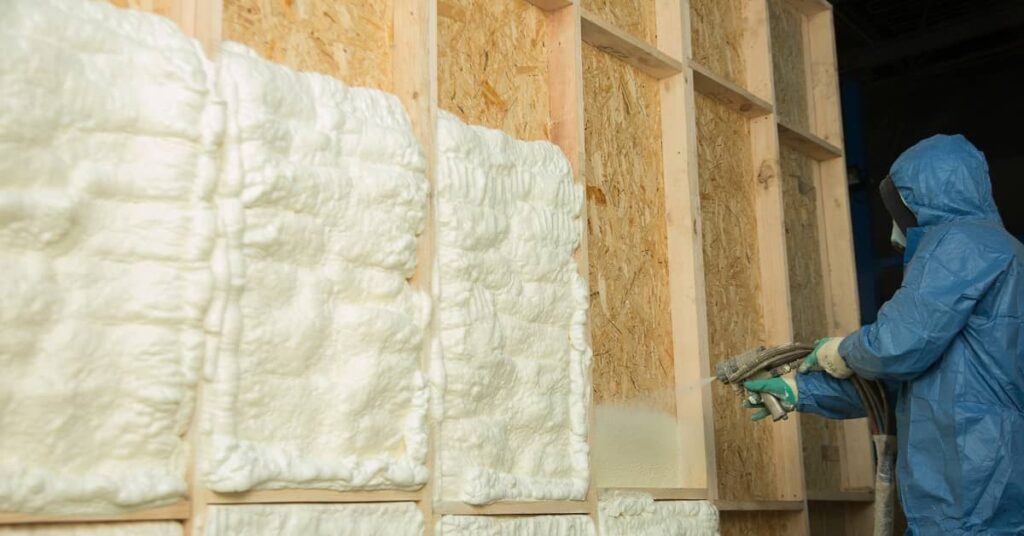Urban noise penetrates homes through gaps, thin walls, and inadequate insulation barriers. Dense insulation materials like mineral wool and spray foam create effective sound barriers by absorbing airborne noise and reducing vibration transmission through building structures. Professional blown-in insulation installation in walls, floors, and ceilings significantly reduces traffic noise, neighbor disturbances, and outdoor sounds that disrupt daily living.
Sound transmission occurs through air gaps and structural vibrations, making comprehensive insulation coverage essential for meaningful noise reduction. Armored Insulation brings proven installation expertise to address specific noise challenges facing Reidland homeowners, from highway traffic to residential activity. This guide examines practical insulation solutions that deliver measurable acoustic improvements for urban homes.
Understanding Sound Transmission Through Building Materials
Sound travels through buildings via two primary pathways: airborne transmission and structural vibration. Airborne sounds pass through gaps around windows, doors, and unsealed penetrations, while impact sounds create vibrations that travel through floors, walls, and ceiling frameworks.
Building materials respond differently to sound frequencies. Standard fiberglass insulation provides moderate noise reduction, primarily absorbing high-frequency sounds. Dense materials like mineral wool excel at blocking both high and low-frequency noise, making them superior choices for urban environments where traffic generates consistent low-frequency rumble.
Wall cavity depth directly impacts noise reduction effectiveness. Standard 2×4 construction limits insulation thickness, while 2×6 framing allows deeper insulation installation for enhanced acoustic performance. Double-wall construction with staggered studs eliminates direct structural connections that transmit vibration.
Bonus Tip: Install acoustic sealant around all electrical outlets and switches in exterior walls. These small gaps allow significant sound transmission despite quality insulation installation.
Insulation Material Comparison for Noise Control
Different insulation materials provide varying levels of acoustic performance based on density, structure, and installation method. Dense materials with irregular fiber patterns absorb more sound energy than lightweight, uniform materials.
| Material Type | NRC Rating | STC Rating | Density (lb/ft³) | Cost Range | Installation Complexity |
| Mineral Wool | 0.90-1.05 | 45-52 | 1.7-2.5 | Moderate | Medium |
| Spray Foam (Closed-cell) | 0.70-0.85 | 39-43 | 2.0-2.2 | High | High |
| Spray Foam (Open-cell) | 0.75-0.90 | 37-41 | 0.5-0.8 | Moderate-High | High |
| Fiberglass Batt | 0.85-0.95 | 34-39 | 0.6-1.0 | Low | Low |
| Blown-in Cellulose | 0.80-0.90 | 44-46 | 1.5-3.5 | Low-Moderate | Medium |
NRC (Noise Reduction Coefficient) measures sound absorption, while STC (Sound Transmission Class) indicates sound blocking capability. Higher numbers represent better acoustic performance for residential applications.
Technical Performance Specifications
Understanding acoustic ratings helps homeowners select appropriate insulation for specific noise challenges. Different rating systems measure distinct aspects of sound control performance.
| Performance Metric | Measurement Range | Application | Interpretation |
| NRC (Noise Reduction Coefficient) | 0.00-1.00 | Sound absorption within rooms | Higher values reduce echo and reverberation |
| STC (Sound Transmission Class) | 20-70+ | Sound blocking between spaces | Each 10-point increase halves perceived noise |
| IIC (Impact Insulation Class) | 25-85+ | Floor/ceiling impact noise | Critical for multi-story homes and apartments |
| Fire Rating | Class A-C | Building code compliance | Class A provides highest fire resistance |
| R-Value | 3.0-7.0 per inch | Thermal performance | Acoustic insulation often provides thermal benefits |
According to the National Association of Home Builders, homes achieving STC ratings above 50 demonstrate significant noise reduction, with residents reporting 75% less perceived noise from external sources. International Building Code requirements specify minimum STC 45 for party walls in multi-family construction.
Climate Considerations for Reidland Installation
Reidland’s humid subtropical climate creates specific installation requirements for acoustic insulation. Summer humidity levels averaging 65-75% require vapor barriers and moisture management to prevent insulation degradation and mold growth.
Temperature fluctuations between 25°F winter lows and 90°F summer highs cause building materials to expand and contract. This movement creates gaps that compromise acoustic performance without proper sealing techniques. Spray foam insulation adapts to thermal movement better than rigid materials.
Bonus Tip: Schedule acoustic insulation installation during fall months when humidity levels stabilize. This timing allows proper curing for spray foam applications and reduces moisture-related installation challenges.
Winter heating demands in Reidland make thermal performance equally important as acoustic benefits. Insulation materials that provide both thermal and acoustic performance deliver better overall value than single-purpose solutions.
Installation Strategies for Maximum Noise Reduction
Comprehensive noise reduction requires attention to detail during installation. Gaps as small as 1% of wall area can reduce acoustic performance by up to 50%, making thorough sealing critical for effective sound control.
Wall Cavity Installation:
- Seal all penetrations first, including electrical boxes, plumbing runs, and HVAC ducts
- Apply acoustic sealant to create airtight barriers preventing sound transmission
- Cut insulation materials to fit snugly around obstacles without compression
- Ensure complete coverage with no gaps or voids
Floor and Ceiling Applications:
- Install dense materials directly against subfloor surfaces for impact noise control
- Account for recessed lighting and HVAC equipment that creates acoustic bridges
- Use different installation techniques for footstep noise versus airborne sound
- Maintain continuous thermal boundary while addressing acoustic performance
Bonus Tip: Install acoustic insulation in two layers with joints offset to eliminate thermal and acoustic bridges. This technique significantly improves performance without requiring specialized materials.
Comprehensive Insulation Solutions from Armored Insulation
Spray Foam Insulation
Advanced polyurethane foam that expands to fill cavities completely, creating superior air sealing and moderate acoustic performance. Open-cell spray foam provides better sound absorption, while closed-cell offers higher structural strength and moisture resistance.
Blown-In Insulation
Loose-fill cellulose or fiberglass installed using pneumatic equipment to achieve consistent density throughout wall cavities. This method effectively fills irregular spaces and provides good acoustic performance at competitive costs.
Fiberglass Batt Insulation
Pre-cut panels designed for standard stud spacing, offering reliable thermal performance and moderate noise reduction. High-density acoustic batts specifically designed for sound control provide enhanced performance over standard products.
Blown-In Wall Insulation
Retrofit installation method for existing walls without removing drywall. Small holes allow dense-pack installation that improves both thermal and acoustic performance in older homes with inadequate insulation.
Mineral Wool Insulation
Dense, fire-resistant material providing excellent acoustic performance and thermal benefits. Superior sound absorption and blocking make mineral wool ideal for urban noise control applications.
Crawl Space Insulation
Foundation area treatment that reduces noise transmission from mechanical equipment and outdoor sources entering through floor systems. Proper crawl space insulation also prevents moisture issues that degrade acoustic performance.
Insulation Removal
Professional extraction of damaged, contaminated, or ineffective insulation materials. Complete removal allows installation of superior acoustic insulation systems and addresses underlying moisture or pest issues.
Things to Consider Before Making a Decision
Budget allocation should account for material costs, professional installation, and long-term performance benefits. While spray foam costs more initially, its superior air sealing may provide better noise reduction than less expensive alternatives requiring additional sealing work.
Existing home construction affects insulation options and installation complexity. Older homes may require electrical updates or structural modifications to accommodate certain insulation types. Professional assessment identifies potential complications before project commitment.
Building code compliance varies by location and project scope. Permit requirements, fire ratings, and vapor barrier specifications impact material selection and installation methods. Professional spray foam insulation contractor ensures code compliance throughout the project.
Maintenance accessibility remains important for long-term performance. Some insulation types require periodic inspection or replacement, while others provide decades of maintenance-free service. Consider future HVAC or electrical work that might disturb insulation installations.
Common Questions About Acoustic Insulation
Which insulation works best for traffic noise? Dense materials like mineral wool and closed-cell spray foam provide superior low-frequency noise blocking essential for traffic noise control. Combining dense insulation with proper air sealing delivers optimal results.
Can existing walls receive acoustic insulation without renovation? Blown-in wall insulation allows retrofit installation through small access holes. This method provides significant improvement without drywall removal, though performance may not match new construction techniques.
How much noise reduction should homeowners expect? Professional acoustic insulation installation typically reduces perceived noise by 40-60%. Actual reduction depends on existing construction, noise frequency, and installation quality.
Does acoustic insulation affect HVAC performance? Properly installed insulation improves HVAC efficiency by reducing air leakage. However, sealing must account for combustion air requirements and proper ventilation to maintain indoor air quality.
Ready to Achieve Peaceful Indoor Living
Effective noise reduction requires professional assessment and quality installation tailored to specific acoustic challenges. Armored Insulation combines proven materials with expert installation techniques to deliver measurable noise reduction for Reidland homeowners.
Professional acoustic insulation installation transforms urban homes into quiet retreats where families enjoy peaceful living despite external noise sources. Contact Armored Insulation today to schedule a comprehensive noise assessment and discover customized solutions for your home’s acoustic challenges.
Armored Insulation
Phone: (270) 727-5566
Email: [email protected]
Frequently Asked Questions
How long does acoustic insulation installation take? Professional installation typically requires 1-3 days depending on home size and insulation type. Spray foam applications need 24-48 hours curing time before occupancy, while batt and blown-in materials allow immediate use.
Will acoustic insulation help with neighbor noise from attached homes? Yes, dense insulation in shared walls significantly reduces neighbor noise transmission. Mineral wool and spray foam provide the best performance for party wall applications in townhomes and duplexes.
Can DIY installation achieve professional acoustic results? Professional installation ensures proper air sealing, complete coverage, and material optimization that DIY projects often miss. Small gaps and installation errors significantly compromise acoustic performance.
Does acoustic insulation require special maintenance? Quality insulation materials require minimal maintenance when properly installed. Annual visual inspection for settlement or damage helps maintain performance, but most materials provide decades of trouble-free service.
How does acoustic insulation affect home resale value? Energy-efficient insulation typically increases home value by 2-6% according to National Association of Realtors data. Acoustic benefits appeal to buyers seeking quiet, comfortable living environments in urban locations.
Reviewer: Mia Clark used her 9 years of experience in spray foam to review this article and offered input focused on helping companies make their services easier to understand and market effectively.
Author: Jared Baker, Owner and Director of Business, brings deep local insight and strong business expertise to Armored Insulation as a native of Mayfield. While continuing a full-time role as a Staff Officer with a federal natural resources agency, has successfully built multiple ventures, including Bluegrass Commercial Cleaning, Animal Tales, and Undercover Properties. As Armored’s Business and Marketing Manager, plays a key role in upholding the company’s focus on delivering top-tier service.








